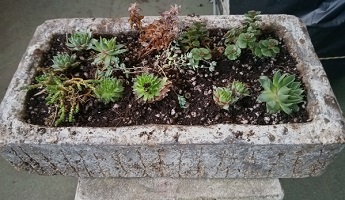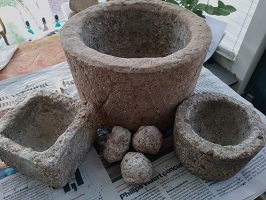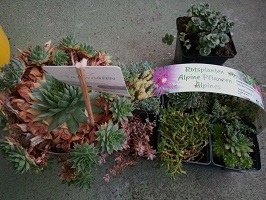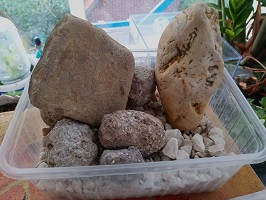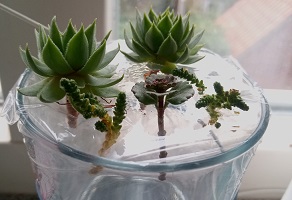THE PLANTERS
To prevent moist conditions, the planters must be porous. This means that moist can find a way through the pot and evaporates at the surface of the outside.
The best material for this purpose is hypertufa. Since the aspect of it is like natural tufa,
it fits perfectly with the intended plants because in their natural environment they also grow on a stony soil.
Another important advantage of hypertufa is that it is light weighted. Planters for succulents can be quite large but still are movable. Last but not least, a hypertufa pot is cheaper than other material. If you can make them yourself, you can give it any size or shape.
THE SOIL
As our plants hate wet feet, we must have a soil that does not retain moist. Also there are not much nutricients required to for our plants to grow.
So we can compose a soil that is only partly made up of organic material. I had peatmoss that i used but that wasn't a success, maybe too acidic. Certain palnts do not grow well, unwanted moss however very good. So i would not recomment this. I mixed equal parts of ordinary potting soil with perlite. And some chicken grid or other finely grinded gravel. This way i get an airy and permeable soil.
Other compositions are possible, for example with river sand, pumice stone, etc.
If we prepare a planter for indoors, the permeability of the pot and the soil are less important. After all, we have full control over the watering. Outdoors we have to deal with rainfall so our planters must be very permeable, especially in winter.
We water when the soil is completely dry which means that our soil is going to float and is easely washed away. We can prevent this with a layer of broken rock (split) on top.
For questions you can mail to hansiart@upcmail.nl
THE PLANTS
Some sedum species for outdoors are: (most of them have subspecies:)
- S acre (goldmoss stonecrop, muurpeper)
- S album (white stonecrop, wit vetkruid)
- S sieboldii (october daphne, oktober-vetkruid)
- S spurium roseum(roze vetkruid)
- S spathulifolium 'Cape Blanco or purpureum'
- S floriferum Weihenstephaner Gold
- S pulchellum (zeesterren vetkruid)
- S Sun Sparkler Sedoro Blue Elf
- S makinoi
- S pachyclados
- S reflexum Angelina
Species not belonging to succulents but may also suitable:
- Thymus serpyllum (creeping thyme, kruiptijm)
- Thymus preacox Coccineus (creeping thyme, kruiptijm)
- Saxifraga (steenbreek) several cultivars
We can choose between plants for indoors and plants for outdoors. Tropical plants such as cacti and echeveria are suitable for indoors. I made a very nice planters with a small aloe vera specimen, a crassula and a cactus.
Outdoors we plant hardy species like sedum and sempervivum. These are species that grow in the mountains so they are hardened against all kinds of weather conditions. The sempervivums are available in 30 subspecies that have different colors and sizes. Very nice compositions can be made with them.
DECORATION
We can decorate our pots with several objects. I made some rocks out of hypertufa to create a real rocky environment. Large pebbles or glass rock or glass nuggets will look nice too.
In garden stores many kinds of colored gravel and sand are sold. A visit can yield a lot of inspiration.
PROPAGATION
Finally, a few words about multiplication of our intended plants.
Usually they are quite easy to propagate, many succulents can root where a piece of the plant touches the soil. There is a lot to find on this subject on the internet.
So in theory we can plant lots of pots with only a few purchased plants. First we can we can tear the purchased plants (sedum) into quarters. Sedum species are easy to propagate with stem cuttings or even by laying some leaves on the soil.
Plants like echeveria or sempervivum make new plants on offshoots themselves. We only have to cut these from the motherplant and put them in soil.
Since i have an empiric mind, i tried a few unusual things. In november i planted cuttings and rosettes of sedum and sempervivum. This is not the time to do this but we'll see. A stem of a sedum spurium in a little liquer bottle rooted within 5 days so it seems to be possible to propagate in winter, if you do this indoors. Little leaves of a sedum species root when they fall into the gaps between the grid on the soil of the pots.
Another experiment: I covered a glass containing 2cm of water with foil. In the foil i poked holes through which i stabbed the stems of sempervivum rosettes, sedum species and delosperma. The stems do not reach the water but hang above it where they root easely in the moist air. Within a few days, even in winter.
Another experiment: In a small transparent food box I put a layer of pumice stone with some water. On this the leaves of sedum and then the lid on it. The leaves should root in the moist atmosphere in the box. In another foodbox i covered the pumice with kitchenpaper and some granite split, to simulate the mountainous conditions. We will see what works best. The first results are bad, some leaves have rotted. Too much water i suspect. I removed the lid to make the conditions dryer.
